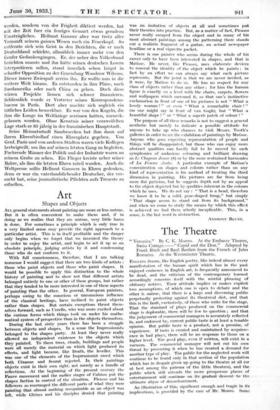Art
Shapes and Objects
ALL general statements about painting are more or less untrue. But it is often convenient to make them and, if in doing so we realize that they are untrue, very little harm is done. For sometimes a principle which is only true in a very limited sense may provide the right approach to a particular artist. This is in itself profitable and the danger only begins when we forget that we invented the theory in order to enjoy the artist, and begin to set it up as an absolute principle, judging artists by it and condemning those who do not conform to it.
With full consciousness, therefore, that I am talking nonsense I would suggest that there are two kinds of artists : those who paint objects and those who paint shapes. It would be possible to apply this distinction to the whole history of painting and to show not that different artists belonged entirely to one or other of these groups, but rather that they tended to be more interested in one of these aspects of painting than the other. In general, European painters, perhaps owing to the conscious or unconscious influence of the classical heritage, have inclined to paint objects rather than shapes. But certain exceptions thrust them- selves forward, such as TJecello, who was more excited about the curious forms which things took on under his mathe- matical system of perspective than in the .objects themselves.
During the last sixty years there has been a struggle between objects and shapes. In a sense the Impressionists belonged to the shapes party. At least they never really allowed an independent existence to the objects which they painted. To them trees, clouds, buildings and people were all merely the material on which light produced its effects, and light became, like Death, the leveller. This was one of the elements of the Impressionist creed which both Cezanne and Seurat rejected. In their paintings objects exist in their own right, not merely as a bundle of reflections. -At the beginning of the present - century the Fauve movement and the earlier stages of Cubism put the shapes faction in control of the situation. Picasso and his followers so rearranged the different parts of what they were painting that almost nothing recognizable as an object was left, while Gleizes and his disciples denied that painting was an imitation of objects at all and sometimes put their theories into practice. But, as a- matter of fact, Picasso never really escaped from the object and in many of his most abstract paintings among the patterning there stands out a realistic fragment of a guitar, an actual newspaper headline or a real cigarette packet.
There is one painter who seems during the whole of his career only to have been interested in shapes, and that is Matisse. He never, like Picasso, uses elaborate devices to conceal the identity of the object which he paints ; in fact by an effort we can always say what each picture represents. But the point is that we are never invited, as it were, by Matisse to do so. He has no respect for any class of objects rather than any other ; for him the human figure is exactly on a level with the chairs, carpets, flowers and wallpapers which surround it, so that one's instinctive exclamation in front of one of his pictures is not "What a lovely woman ! " or even "What a remarkable chair!" (as one might say in front of van Gogh), but "What a beautiful shape ! " or "What a superb patch of colour ! "
The purpose of all these remarks is not to suggest a general aesthetic but merely to indicate a possible attitude for anyone to take up who chances to visit Messrs. Tooth's galleries in order to see the exhibition of paintings by Matisse. Anyone who goes expecting representation of people and things will be disappointed, but those who can enjoy more abstract qualities can hardly fail to be moved by such symphonies of audacious colouring and brilliant drawing as Lc Chapeau Jaunt. (8) or by the more restrained harmonies of La Femme Arabc. A particular example of Matisse's concentration on shapes and colours rather than on any kind of representation is his method of treating the third dimension in painting. His pictures are far from being mere flat patterns, but he suggests depth not by an appeal to the object depicted but by qualities inherent in the colours which he uses. We do not say : "That is a head, therefore we know it to be a solid, pear-shaped lump," but simply "That shape seems to stand out from its background," and when we come to study the means by which this effect is achieved we find them utterly inexplicable. This, in a sense, is the last word in abstraction.
Awrnotql- BLUNT.










































 Previous page
Previous page